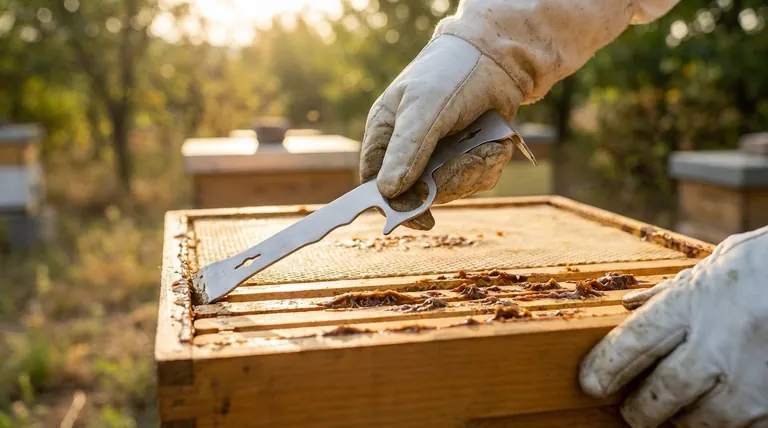Harvesting propolis is a straightforward process that leverages the bees' natural instinct to seal their hive. The core steps involve checking that your colony is strong, adding a specialized propolis trap during the peak production season, collecting the trap once it's filled, and then freezing it to make the brittle propolis easy to remove.
The key to successful and sustainable propolis harvesting is not just following the steps, but understanding the timing. You must align your collection with the bees' natural late-season production cycle while ensuring the colony retains more than enough of this vital resource for its own health and survival.

The Foundation: Understanding Propolis and Hive Health
What is Propolis?
Propolis, often called "bee glue," is a resinous mixture produced by honeybees. They create it by combining tree sap with their own saliva and beeswax.
Bees use this sticky, greenish-brown substance as a sealant for unwanted open spaces in the hive. It acts as a critical waterproofing and insulating agent, protecting the colony from the elements.
The Pre-Harvest Assessment
Before you consider harvesting, your first step is always to assess the hive's condition. You should only harvest from colonies that are thriving and producing an excessive amount of propolis.
A strong, populous hive can easily spare the surplus. Attempting to harvest from a weak or struggling colony can deprive it of a resource it desperately needs for survival, especially heading into winter.
The Harvesting Process, Step-by-Step
Strategic Timing: When to Harvest
The ideal time to harvest propolis is during late summer and early fall. This is when bees are most actively working to seal cracks and prepare their hive for the coming winter, leading to peak propolis production.
By timing your harvest with this natural cycle, you work with the bees' instincts rather than against them.
Introducing the Propolis Trap
The most efficient method for collection is a propolis trap, which is typically an inexpensive and reusable plastic mat. These mats are designed with small grooves or gaps.
When placed on top of the hive frames, the bees perceive these gaps as cracks that must be sealed. They will proceed to fill the trap with propolis, doing the collection work for you.
Collection and Removal
After a few weeks, you can check the trap. Once the grooves are substantially filled with propolis, the trap is ready to be collected.
Simply remove the trap from the hive. At this stage, the propolis will be soft and incredibly sticky, making it nearly impossible to remove from the mat.
The Freeze-and-Crack Method
The final step is the most critical for easy processing. Place the entire propolis trap into a freezer for several hours.
Freezing makes the propolis extremely brittle and hard, while the plastic trap remains flexible. You can then twist or bend the mat, causing the frozen propolis to crack and break off cleanly.
Understanding the Trade-offs: Sustainable Harvesting
The Risk of Over-Harvesting
Propolis is essential for the colony's well-being. It provides insulation against cold and serves as a barrier to moisture and drafts.
Removing too much propolis, especially late in the fall, can compromise the hive's ability to successfully overwinter. Responsible beekeepers always prioritize the needs of the bees.
Prioritizing Colony Health Over Yield
The golden rule of sustainable beekeeping is to harvest only the surplus. A healthy hive will produce more propolis than it needs.
Always stop harvesting well before winter sets in. This ensures the bees have ample time and resources to fully insulate and protect their home for the cold months ahead.
Making the Right Choice for Your Goal
- If your primary focus is maximizing yield ethically: Install propolis traps in your strongest hives during the peak late-summer and early-fall production window.
- If your primary focus is colony health and sustainability: Harvest conservatively, always leaving more propolis than you take and stopping all collection efforts as winter approaches.
By aligning your harvesting practices with the bees' natural cycle and needs, you can gather this valuable resource responsibly and effectively.
Summary Table:
| Step | Key Action | Purpose |
|---|---|---|
| 1. Pre-Harvest | Assess hive strength | Ensure colony is thriving and has surplus propolis |
| 2. Timing | Install trap in late summer/early fall | Align with bees' natural peak production cycle |
| 3. Collection | Use a propolis trap on the hive | Let bees fill the trap with propolis for easy collection |
| 4. Removal | Freeze the filled trap | Makes propolis brittle and easy to separate from the trap |
Ready to harvest propolis efficiently and sustainably?
For commercial apiaries and beekeeping equipment distributors, having the right tools is essential for a successful harvest. HONESTBEE supplies the durable, wholesale-focused beekeeping supplies and equipment you need—from propolis traps to essential hive management tools.
Contact HONESTBEE today to discuss your wholesale needs and ensure your operation is equipped for sustainable, high-yield propolis collection.
Visual Guide

Related Products
- HONESTBEE Advanced Ergonomic Stainless Steel Hive Tool for Beekeeping
- Professional Galvanized Hive Strap with Secure Locking Buckle for Beekeeping
- Langstroth Screen Bottom Board for Beekeeping Wholesale
- Honey Concentrating Vacuum Heating Thickening Machine Dehumidifier for Honey
- 0.5T Capacity Honey Dehumidifier Dryer with Vacuum Heating and Thickening Filtering Machine
People Also Ask
- What is the hole in a hive tool for? A Multi-Tool for Apiary Repairs and Maintenance
- What tools are used for cleaning frames? A Beekeeper's Simple 4-Tool Guide
- How should beekeepers handle bees when using a hive tool? Master Calm, Deliberate Techniques
- What are the features of a regular hive tool? The Essential Multi-Tool for Every Beekeeper
- What are some common uses of a hive tool? Essential Multi-Purpose Tool for Every Beekeeper



















